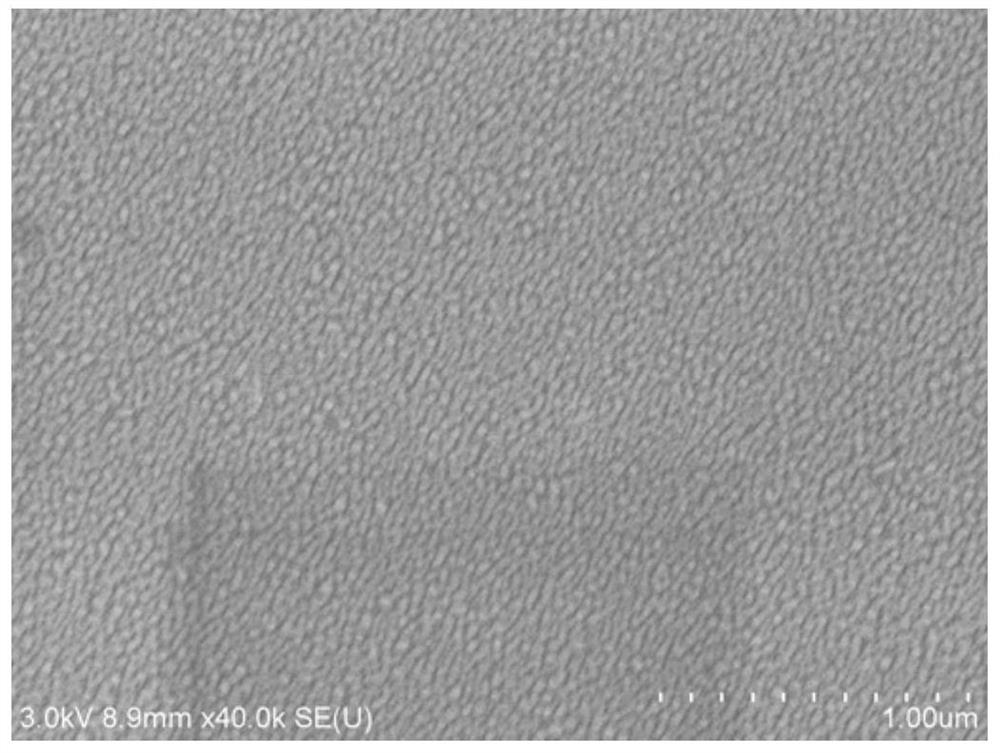A preparation method of chlorine-resistant aromatic polyamide composite nanofiltration membrane
An aromatic polyamide and composite nanofiltration membrane technology, applied in the field of membrane separation, can solve problems such as membrane separation performance deterioration, and achieve the effects of not easy to run off, improved water permeability and retention rate, and convenient operation.
- Summary
- Abstract
- Description
- Claims
- Application Information
AI Technical Summary
Problems solved by technology
Method used
Image
Examples
Embodiment 1
[0025] (1) Monomer solution configuration: m-phenylenediamine was dissolved in water to prepare an aqueous phase solution with a mass concentration of 1%, and trimesoyl chloride was dissolved in n-hexane to prepare an organic phase solution with a mass concentration of 0.01%;
[0026] (2) Interface polymerization: soak the polyvinylidene fluoride ultrafiltration bottom membrane in the aqueous phase solution for 30 minutes, take it out and remove the excess aqueous phase solution on the surface of the membrane with an air knife, and then immerse it in the organic phase solution for 30 seconds to carry out interfacial polymerization After reaction, the membrane was taken out and drained, heat-treated in an oven at 70°C for 5 minutes, then soaked in deionized water for 24 hours to remove unreacted monomers to obtain an aromatic polyamide composite nanofiltration membrane;
[0027] (3) Membrane surface activation: configure the activation solution of 1-(3-dimethylaminopropyl)-3-eth...
Embodiment 2
[0032] (1) Monomer solution configuration: o-phenylenediamine was dissolved in water to prepare an aqueous phase solution with a mass concentration of 15%, and biphenyltetrayl chloride was dissolved in n-hexane to prepare an organic phase solution with a mass concentration of 2%;
[0033] (2) Interface polymerization: soak the polysulfone ultrafiltration bottom membrane in the aqueous phase solution for 30 minutes, take it out and use an air knife to remove excess aqueous phase solution on the membrane surface, then immerse it in the organic phase solution for 30 seconds to carry out interfacial polymerization reaction, Then the membrane was taken out and drained, heat-treated in an oven at 100°C for 3 minutes, then soaked in deionized water for 24 hours to remove unreacted monomers to obtain an aromatic polyamide composite nanofiltration membrane;
[0034] (3) Membrane surface activation: configure the activation solution of 1-(3-dimethylaminopropyl)-3-ethylcarbodiimide hydroc...
Embodiment 3
[0038] (1) Monomer solution configuration: Dissolving syrylenetriamine in water to prepare an aqueous phase solution with a mass concentration of 0.1%, dissolving terephthaloyl chloride in n-hexane to prepare an organic phase solution with a mass concentration of 1%;
[0039](2) Interface polymerization: soak the polyacrylonitrile ultrafiltration bottom membrane in the aqueous phase solution for 30 minutes, take it out and remove the excess aqueous phase solution on the surface of the membrane with an air knife, and then immerse it in the organic phase solution for 30 seconds to carry out interfacial polymerization reaction , and then the membrane was taken out and drained, heat-treated in an oven at 50°C for 7 minutes, then soaked in deionized water for 24 hours to remove unreacted monomers to obtain an aromatic polyamide composite nanofiltration membrane;
[0040] (3) Membrane surface activation: configure the activation solution of 1-(3-dimethylaminopropyl)-3-ethylcarbodiimi...
PUM
| Property | Measurement | Unit |
|---|---|---|
| thickness | aaaaa | aaaaa |
Abstract
Description
Claims
Application Information
 Login to View More
Login to View More - R&D
- Intellectual Property
- Life Sciences
- Materials
- Tech Scout
- Unparalleled Data Quality
- Higher Quality Content
- 60% Fewer Hallucinations
Browse by: Latest US Patents, China's latest patents, Technical Efficacy Thesaurus, Application Domain, Technology Topic, Popular Technical Reports.
© 2025 PatSnap. All rights reserved.Legal|Privacy policy|Modern Slavery Act Transparency Statement|Sitemap|About US| Contact US: help@patsnap.com


